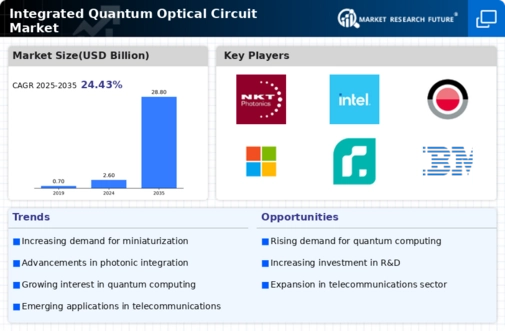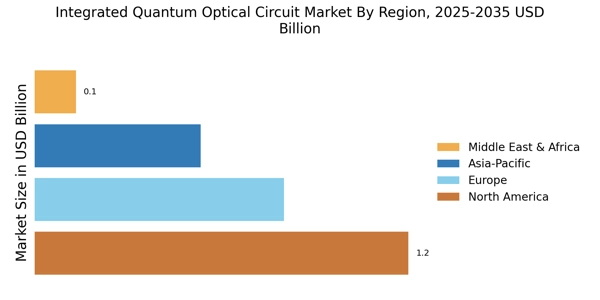The Integrated Quantum Optical Circuit Market is currently characterized by a dynamic competitive landscape, driven by rapid technological advancements and increasing investments in quantum computing. Major players such as IBM (US), Google (US), and Xanadu (CA) are at the forefront, each adopting distinct strategies to enhance their market positioning. IBM (US) focuses on innovation through its Quantum System One, which integrates quantum circuits with classical computing, thereby facilitating hybrid solutions. Google (US), on the other hand, emphasizes its leadership in quantum supremacy, leveraging its Sycamore processor to push the boundaries of quantum algorithms. Meanwhile, Xanadu (CA) is carving a niche in photonic quantum computing, aiming to democratize access to quantum technologies through its cloud platform, which collectively shapes a competitive environment that is both collaborative and competitive.
In terms of business tactics, companies are increasingly localizing manufacturing and optimizing supply chains to enhance operational efficiency. The market structure appears moderately fragmented, with a blend of established tech giants and emerging startups. This fragmentation allows for diverse innovation pathways, although the collective influence of key players like Microsoft (US) and Intel (US) remains substantial, as they leverage their extensive resources to drive advancements in integrated quantum optical circuits.
In August 2025, IBM (US) announced a strategic partnership with a leading telecommunications provider to develop quantum-enhanced communication networks. This collaboration is poised to revolutionize secure data transmission, highlighting IBM's commitment to integrating quantum technologies into practical applications. Such initiatives not only bolster IBM's market presence but also signify a broader trend towards the convergence of quantum computing and telecommunications.
In September 2025, Google (US) unveiled its latest quantum processor, which reportedly achieves unprecedented coherence times, enhancing the reliability of quantum computations. This development underscores Google's ongoing investment in research and development, positioning it as a leader in the quest for scalable quantum solutions. The implications of this advancement could be profound, potentially accelerating the timeline for practical quantum applications across various industries.
In July 2025, Xanadu (CA) launched a new version of its cloud-based quantum computing platform, which now includes enhanced tools for developers. This move is indicative of Xanadu's strategy to foster a robust ecosystem around its technology, encouraging innovation and collaboration among researchers and businesses. By making quantum computing more accessible, Xanadu is likely to attract a wider user base, further intensifying competition in the market.
As of October 2025, the Integrated Quantum Optical Circuit Market is witnessing trends that emphasize digitalization, sustainability, and the integration of artificial intelligence. Strategic alliances are increasingly shaping the competitive landscape, as companies recognize the value of collaboration in accelerating technological advancements. Looking ahead, it appears that competitive differentiation will evolve from traditional price-based competition to a focus on innovation, technological prowess, and supply chain reliability, suggesting a transformative shift in how companies position themselves in this burgeoning market.

















Leave a Comment